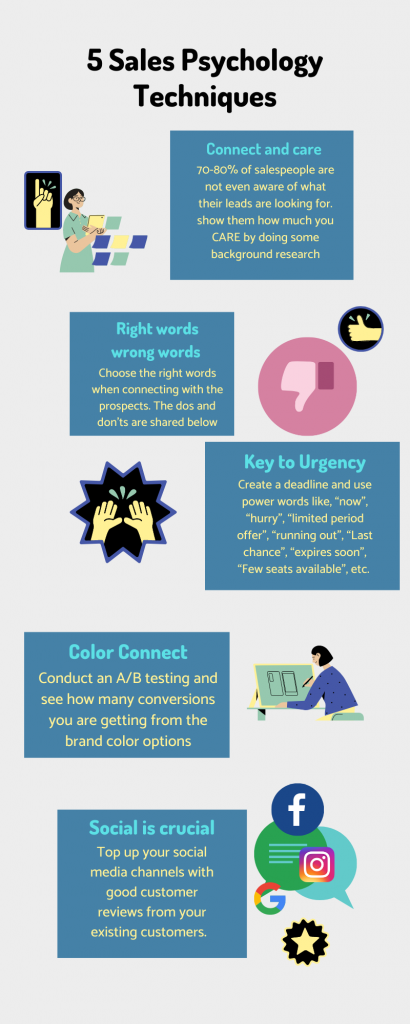Being a sales pro itself is a psychological game of understanding people you don’t know. Needless to say, sales and psychology are co-dependent on each other to convince your leads to finally make a purchase.
It gets all the more challenging if you’re constantly dealing with cold calls, isn’t it? Tapping into the psyche of strangers is itself a complex task and it gets more taxing when they don’t even listen to you.
In the latest research, it is observed that the customers don’t pay enough attention to sales pitches. Why? Because you don’t know anything about them. How can you pitch a product to someone you are completely unaware of?
Let’s start off with some of the best tried and tested psychology techniques to tap into the minds of your leads better.

1. Connect and care
Do you know what your lead actually wants? 70-80% of salespeople are not even aware of what their leads are looking for. For instance, if you try to sell a credit card to a person who already has 5 credit cards, do you think that person will be interested to buy it? Instead, it is always advisable to do some background research about the needs of your potential customers so that you can actually show them how much you CARE.
In this digital world, it is not that difficult to get access to limited information about your target market and collate a data sheet based on your findings.
I could recall an interesting incident where I had a cab driver convert into a customer. How? I was then working for an education brand that provides job-assured vocational courses.
Since I like interacting with people, I ended up knowing how he wants his daughter to opt for a post-graduation course that offers placement facilities at a minimal cost. I told him about the low-priced vocational courses that offer scholarship programs as well. And voila! He immediately inquired about the course and I got his daughter onboarded for the scholarship program within a month.
So yes, connect with more and more people whenever you can and show them how much of a problem solver you can be to them.
2. Right words wrong words
So the sales training wasn’t helpful enough to help you understand the difference between the right and wrong choice of words? Let me cut to the chase and share a few instances of dos and don’ts collected from some field experts to help you gauge the psychology of your audience better.
What not to say
- “Trust me, we are offering the best price for this product in the market.”
- “Honestly speaking, only we are offering this product at such affordable prices.”
- “To be honest, we want all our customers to get the best quality products at the least price possible”.
(All the above examples will just make your prospect run away and ghost you. I am certain you do not want that to happen.)
What to say
- “Feel free to compare our prices in the market, you will realize we are offering the best price”
- “I can provide you with the statistics so you can figure out how you will benefit from our partnership.”
- “Please let me know if you have any doubts, I can provide you with genuine facts and figures to clarify them”.
(Facts and figures can never go wrong when it comes to gaining the faith of your prospects. They are undeniable and can convince anyone easily. Use less flattering words and put forth your compelling statistics.)
Also read: 7 emotions every sales expert should master to close more deals
3. Key to Urgency
This is a common practice but definitely deserves a mention here. It is important to add a timeline to your sale. For inspiration, you can browse some timeline templates online. When there is a sense of urgency, your lead would make an effort to do some background research and then get back to you based on the offers you are providing.
Whether it’s a cold email or a reach-out call, maintain a personalized approach where you claim to provide an offer specifically to him/her. Or you can also say the product is limited edition to create a feeling of scarcity. You should also mention that the offer has a deadline and they should grab this too-good-to-miss opportunity.
You can also create images and talk about the deadline or power words like, “now”, “hurry”, “limited period offer”, “running out”, “Last chance”, “expires soon”, “Few seats available”, etc.
4. Color Connect
Color plays a major part in connecting with the psyche of your audience. If needed, you can conduct A/B testing and see how many conversions are you getting from the brand color options. I recently came across an article about Hubspot about how they got better conversion rates with colors like red, yellow, and orange than colors like green and blue.
Based on your business goals and objectives offer color options they would be more inclined to. The color options can be anything you choose from a color palette. Shortlist the best options from the lot and use those in your A/B testing campaigns,
5. Social is crucial
There’s a marketing strategy called “social proof”. It’s a term coined by professor of marketing and psychology, Robert Cialdini. This is one of the best practices when building your sales strategy. Top up your social media channels with good customer reviews from your existing customers. It’s a fail-safe way to add credibility to your brand and play affirmatively with the psyche of your target audience.
People, in general, are more likely to hanker for something that is already liked by many others. Don’t forget to promote them on social media, newsletters, and proposals to impress your prospects.
You may also find some deeper insights in this blog – 9 psychology tricks you can use to improve cold calling and win more leads


